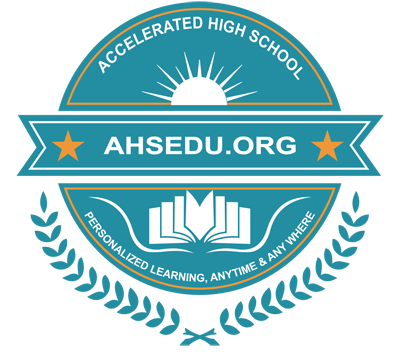Accelerated High School
Standardized Curriculum of General Mathematics-V
Mathematical knowledge and skills are essential for navigating the complexities of the 21st century. Understanding and applying mathematical concepts is crucial for personal decision-making, civic participation, and career readiness. Accelerated High School (AHS) aligns its curriculum with various educational standards to ensure comprehensive coverage of mathematical principles and their practical applications.
Mission:
All students will understand the mathematical concepts and processes required for personal decision-making, participation in civic life, and preparation for future academic and career pursuits.
Vision:
Prepare students to become mathematically literate individuals who can effectively:
- Apply mathematical thinking and skills to solve real-world problems.
- Engage in logical reasoning and develop problem-solving strategies.
- Conduct investigations, analyze data, and interpret results.
- Discuss mathematical concepts and their applications.
- Read and evaluate multiple sources of mathematical information.
- Communicate mathematical ideas through various forms, including reports, presentations, and visual displays.
Spirit and Intent:
The AHS mathematics curriculum has been prepared and standardized following The New Jersey Student Learning Standards (NJSLS), including the Student Learning Standards for Career Readiness, Life Literacies, and Key Skills, as well as the Student Learning Standards for Personal Financial Literacy. These standards outline the expectations for what students should know and be able to do, promoting a comprehensive approach to mathematical instruction. From the earliest grades, students are expected to engage in learning experiences that develop their understanding of mathematical concepts, improve their problem-solving skills, and enhance their ability to apply mathematics in various contexts.
Three Dimensions of AHS Mathematics Curriculum:
In Grade 5, instructional time should focus on three critical areas:
(1) developing fluency with addition and subtraction of fractions, and developing an understanding of the multiplication of fractions and division of fractions in limited cases (unit fractions divided by whole numbers and whole numbers divided by unit fractions);
(2) extending division to 2-digit divisors, integrating decimal fractions into the place value system and developing understanding of operations with decimals to hundredths, and developing fluency with whole number and decimal operations;
(3) developing understanding of volume.
(1) Students apply their understanding of fractions and fraction models to represent the addition and subtraction of fractions with unlike denominators as equivalent calculations with like denominators. They develop fluency in calculating sums and differences of fractions and make reasonable estimates of them. Students also use the meaning of fractions, multiplication, and division, and the relationship between multiplication and division to understand and explain why the procedures for multiplying and dividing fractions make sense. (Note: this is limited to the case of dividing unit fractions by whole numbers and whole numbers by unit fractions.)
(2) Students develop an understanding of why division procedures work based on the meaning of base-ten numerals and properties of operations. They finalize fluency with multi-digit addition, subtraction, multiplication, and division. They apply their understanding of models for decimals, decimal notation, and properties of operations to add and subtract decimals to hundredths. They develop fluency in these computations and make reasonable estimates of their results. Students use the relationship between decimals and fractions, as well as the relationship between finite decimals and whole numbers (i.e., a finite decimal multiplied by an appropriate power of 10 is a whole number), to understand and explain why the procedures for multiplying and dividing finite decimals make sense. They compute products and quotients of decimals to hundredths efficiently and accurately.
(3) Students recognize volume as an attribute of three-dimensional space. They understand that volume can be measured by finding the total number of same-size units of volume required to fill the space without gaps or overlaps. They understand that a 1-unit by 1-unit by 1-unit cube is the standard unit for measuring volume. They select appropriate units, strategies, and tools for solving problems that involve estimating and measuring volume. They decompose three-dimensional shapes and find volumes of right rectangular prisms by viewing them as decomposed into layers of arrays of cubes. They measure the necessary attributes of shapes to determine volumes to solve real-world and mathematical problems.
Curriculum for Grade-V Mathematics
Standard 1: Number and Operations in Base Ten
Learning Objectives:
- Understand the place value system.
- Recognize that in a multi-digit number, a digit in one place represents 10 times as much as it represents in the place to its right and 1/10 of what it represents in the place to its left.
- Fluently add and subtract using strategies and algorithms based on place value, properties of operations, and/or the relationship between addition and subtraction.
- Explain patterns in the number of zeros of the product when multiplying a number by powers of 10, and explain patterns in the placement of the decimal point when a decimal is multiplied or divided by a power of 10. Use whole-number exponents to denote powers of 10.
- Multiply a whole number of up to four digits by a one-digit whole number, and multiply two two-digit numbers, using strategies based on place value and the properties of operations.
- Find whole-number quotients and remainders with up to four-digit dividends and one-digit divisors, using strategies based on place value, the properties of operations, and/or the relationship between multiplication and division.
Topics of AHS-GM:
Whole numbers and place value:
- Convert between standard and expanded form
- Place value
- Relationship between place values
- Write numbers in words
- Spell word names for numbers up to one million
- Roman numerals I, V, X, L, C, D, M
Add and subtract:
- Add and subtract whole numbers up to billions
- Add and subtract whole numbers: word problems
Power of ten:
- Understanding powers of ten
- Evaluate powers of ten
- Write powers of ten with exponents
Multiplication:
- Multiply 2-digit numbers by 3-digit numbers
- Multiply 2-digit numbers by larger numbers
Division:
- Divide numbers ending in zeros
- Divide multi-digit numbers by 1-digit numbers
- Divide 2-digit and 3-digit numbers by 2-digit numbers
Standard 2: Operations and Algebraic Thinking
Learning Objectives:
- Use place value understanding and properties of operations to perform multi-digit arithmetic.
Topics of AHS-GM:
Mixed operations - whole numbers:
- Add, subtract, multiply, and divide whole numbers
- Add, subtract, multiply, and divide whole numbers: word problems
Standard 3: Number and Operations in Base Ten
Learning Objectives:
- Add, subtract, multiply, and divide decimals to hundredths, using concrete models or drawings and strategies based on place value, properties of operations, and/or the relationship between addition and subtraction; relate the strategy to a written method and explain the reasoning used.
Topics of AHS-GM:
Add and subtract decimals:
- Add decimal numbers
- Subtract decimal numbers
Multiply decimals:
- Multiply a decimal by a one-digit whole number
- Multiply a decimal by a multi-digit whole number
Divide decimals:
- Division with decimal quotients
- Division with decimal quotients and rounding
- Divide by decimals without adding zeros
- Divide by decimals
Mixed operation - Decimals:
- Add, subtract, multiply, and divide decimals
- Add, subtract, multiply, and divide decimals: word problems
Standard 4: Number and Operations – Fractions
Learning Objectives:
- Use equivalent fractions as a strategy to add and subtract fractions.
- Add and subtract fractions with unlike denominators (including mixed numbers) by replacing given fractions with equivalent fractions in such a way as to produce an equivalent sum or difference of fractions with like denominators.
- Apply and extend previous understandings of multiplication and division to multiply and divide fractions.
- Find the area of a rectangle with fractional side lengths by tiling it with unit squares of the appropriate unit fraction side lengths, and show that the area is the same as would be found by multiplying the side lengths. Multiply fractional side lengths to find areas of rectangles, and represent fraction products as rectangular areas.
Topics of AHS-GM:
Add and subtract fractions:
- Add fractions with unlike denominators
- Subtract fractions with unlike denominators
- Add 3 or more fractions with unlike denominators
- Add and subtract mixed numbers
Multiply and divide fractions:
- Multiply two fractions
- Multiply three fractions and whole numbers
- Divide unit fractions by whole numbers
- Divide whole numbers by unit fractions
Area:
- Area of squares and rectangles
- Area of rectangles with fractions
- Area of rectangles with fractions and mixed numbers
- Area of compound figures
Perimeter:
- Perimeter with whole number side lengths
- Perimeter with decimal side lengths
- Perimeter with fractional side lengths







